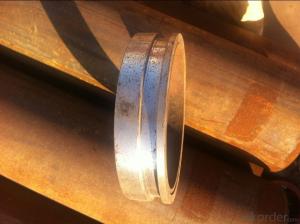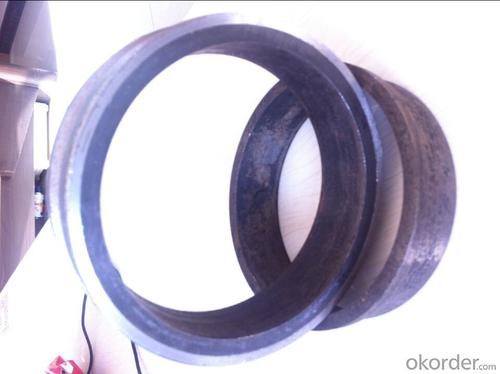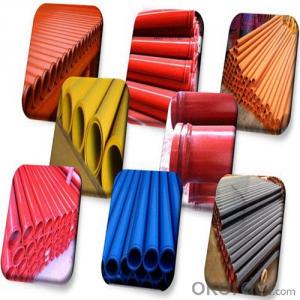Long Life Flange with Wearing Insert DN 125 MM Width 40MM
- Loading Port:
- Tianjin
- Payment Terms:
- TT or LC
- Min Order Qty:
- 50 set
- Supply Capability:
- 5000 set/month
OKorder Service Pledge
OKorder Financial Service
You Might Also Like
Product Description:
Product Name: Concrete Pump Flange with Wearing Insert
1. Specification of Flange
Materials: Steel 20
Inner Diameter: 125mm
Wearing Insert:Bearing Steel
Notes: total series of concrete pump elbows for different brand concrete pump(PUTZMEISTER, SCHWING, CIFA, SANY, ZOOMLION, IHI, KYOKUTO Etc)available from us.
2. Application of Concrete Pump Flange
Our concrete pump elbows have been successfully exported to many countries from 1998, Our main markets asbelow: Middle East, Southeast Asia, America, Brazil, Italy, Russia, South Africa etc
Aiming at the largest concrete pump parts manufacturer, and reliable, professional supplier in China, we can
supply concrete pump elbows, delivery pipes, casting or forging couplings, end rubber hoses, rubber pistons,
tungsten wear plates, delivery cylinders, and other hydraulic parts, one stop service for your concrete pump
parts and accessory business.
3. Package and Delivery of Concrete Pump Flange
Every 60pcs put in one seaworthy wooden box, and 20 boxes in one 20feet container.
Optional wood materials: veneer wood or other wood.




- Q: How does a concrete pump agitator motor prevent concrete from settling?
- A concrete pump agitator motor prevents concrete from settling by continuously rotating and agitating the mixture, ensuring that the aggregate, cement, and water remain well-mixed. This agitation action prevents the heavier components from sinking and settling at the bottom, maintaining a homogeneous consistency throughout the concrete.
- Q: What are the different types of concrete pump wear rings?
- There are several different types of concrete pump wear rings that are commonly used in the construction industry. The most common types include: 1. Metallic Wear Rings: These wear rings are typically made of hardened steel or stainless steel. They are highly durable and can withstand the abrasive nature of concrete. Metallic wear rings are designed to be long-lasting and provide excellent wear resistance. 2. Polyurethane Wear Rings: Polyurethane wear rings are made from a high-performance polymer material. They are known for their exceptional resistance to abrasion, impact, and chemical exposure. Polyurethane wear rings are often preferred for their flexibility and ability to provide a tight seal, reducing leakage and improving pump performance. 3. Ceramic Wear Rings: Ceramic wear rings are made from a high-density ceramic material, such as alumina or zirconia. They are extremely hard and have excellent resistance to wear and corrosion. Ceramic wear rings are commonly used in high-pressure applications where there is a need for superior durability and performance. 4. Composite Wear Rings: Composite wear rings are made by combining different materials, such as metal and polymer, to create a hybrid material. These wear rings offer the advantages of both materials, such as the strength of metal and the flexibility of polymers. Composite wear rings are often used in applications where a balance between durability and flexibility is required. Each type of wear ring has its own unique advantages and considerations. The choice of wear ring depends on various factors, such as the specific application, operating conditions, and budget constraints. It is important to consult with experts or manufacturers to determine the most suitable wear ring for a concrete pump.
- Q: Are there any specific guidelines for the disposal of old or damaged concrete pump spare parts?
- Yes, there are specific guidelines for the disposal of old or damaged concrete pump spare parts. It is recommended to contact local waste management authorities or recycling facilities to inquire about proper disposal methods. In many cases, recycling concrete pump spare parts is encouraged to reduce environmental impact.
- Q: How often should concrete pump outriggers be inspected and maintained?
- Concrete pump outriggers should be inspected and maintained regularly to ensure their safe and efficient operation. It is recommended to inspect and maintain concrete pump outriggers before each use and at least once every six months. However, the frequency of inspections may vary depending on the specific conditions and intensity of use. Regular inspections should include checking the condition of the outrigger pads, hydraulic cylinders, and other components for any signs of wear, damage, or leaks. Any necessary repairs or replacements should be carried out promptly to prevent further damage and ensure the outriggers are in proper working condition. Additionally, proper lubrication of moving parts and regular cleaning of the outriggers can help prolong their lifespan and maintain their performance.
- Q: What are the different types of concrete pump pistons?
- There are several different types of concrete pump pistons that are commonly used in the construction industry. These include: 1. Single-acting pistons: These pistons have one working side and are used in smaller concrete pumps. They push the concrete out of the cylinder during the forward stroke and rely on gravity to pull the piston back during the return stroke. 2. Double-acting pistons: These pistons have two working sides and are used in larger concrete pumps. They push the concrete out during the forward stroke and pull it back during the return stroke, increasing the efficiency of the pumping process. 3. S-tube pistons: These pistons are shaped like an S and are commonly used in trailer-mounted concrete pumps. They help to control the flow of concrete by directing it through a series of valves and pipes. 4. Rock valve pistons: These pistons are designed specifically for pumping concrete with larger aggregates. They have a rugged design that can handle the more abrasive nature of these types of materials. 5. Gate valve pistons: These pistons use a gate valve system to control the flow of concrete. They are commonly used in high-pressure applications and offer precise control over the amount of concrete being pumped. Overall, the type of concrete pump piston used will depend on the specific requirements of the construction project, including the size of the pump, the type of concrete being pumped, and the desired flow rate and pressure.
- Q: What are the indications of a faulty concrete pump hydraulic motor?
- Some indications of a faulty concrete pump hydraulic motor may include decreased pumping efficiency, irregular or inconsistent flow of concrete, unusual noises or vibrations, leaks or drips in the hydraulic system, excessive heat in the motor, or difficulty in starting or stopping the motor.
- Q: What are the different types of concrete pump rubber hoses?
- There are several different types of concrete pump rubber hoses available in the market. 1. Steel Wire Reinforced Hose: This is the most common type of concrete pump rubber hose. It is reinforced with multiple layers of steel wire to provide maximum strength and durability. Steel wire reinforced hoses are suitable for high-pressure applications and can handle the heavy pumping of concrete with ease. 2. Textile Reinforced Hose: This type of hose is reinforced with multiple layers of textile fabric, such as nylon or polyester. Textile reinforced hoses are generally lighter in weight compared to steel wire reinforced hoses, making them easier to handle and maneuver. They are suitable for medium-pressure applications and are commonly used in smaller concrete pumps. 3. Fabric Hose: Fabric hoses are made from a single layer of fabric, such as nylon or polyester. They are lightweight and flexible, making them easy to handle and transport. Fabric hoses are suitable for low-pressure applications and are commonly used in small-scale construction projects. 4. Composite Hose: Composite hoses are made from a combination of different materials, such as rubber and plastic. These hoses are lightweight and highly flexible, making them suitable for applications where maneuverability is crucial. Composite hoses are commonly used in smaller concrete pumps and can handle both low and medium pressure. 5. Flanged Hose: Flanged hoses have flanges attached at both ends of the hose, which are used to connect the hose to the pump and the nozzle. Flanged hoses provide a secure connection and prevent any leaks or disconnections during the pumping process. They are commonly used in high-pressure applications and are suitable for large-scale construction projects. Overall, the choice of concrete pump rubber hose depends on the specific requirements of the project, including the pressure, size, and type of concrete being pumped. It is important to select the right type of hose to ensure efficient and safe concrete pumping operations.
- Q: What is the purpose of a concrete pump hopper grate?
- The purpose of a concrete pump hopper grate is to filter out any large debris or aggregates from the concrete mixture as it is being pumped into the hopper. It helps to ensure a smooth and consistent flow of concrete, preventing any blockages or clogs in the pump system.
- Q: What is the function of a concrete pump remote control?
- A concrete pump remote control serves as a tool to operate and control the functions of a concrete pump from a distance. It allows the operator to manipulate various aspects of the pump's operation, such as starting and stopping the pumping process, adjusting the speed and direction of the pump, and controlling the placement and flow of the concrete. By providing remote control capabilities, it eliminates the need for the operator to be physically close to the pump, allowing for safer and more efficient operation. Additionally, the remote control often includes features such as emergency stop buttons, diagnostics, and data logging capabilities, which further enhance the functionality and reliability of the concrete pump. Overall, the function of a concrete pump remote control is to provide convenience, precision, and safety in the operation of concrete pumping equipment.
- Q: How often should concrete pump S valves be inspected and replaced?
- Concrete pump S valves should be inspected regularly, ideally every 500 hours of operation or at least once a year. However, the replacement of S valves will depend on various factors such as the quality of the concrete being pumped, the frequency of use, and the overall condition of the valve. It is recommended to consult the manufacturer's guidelines and seek professional advice to determine the specific timing of S valve replacement.
Send your message to us
Long Life Flange with Wearing Insert DN 125 MM Width 40MM
- Loading Port:
- Tianjin
- Payment Terms:
- TT or LC
- Min Order Qty:
- 50 set
- Supply Capability:
- 5000 set/month
OKorder Service Pledge
OKorder Financial Service
Similar products
Hot products
Hot Searches
Related keywords






















